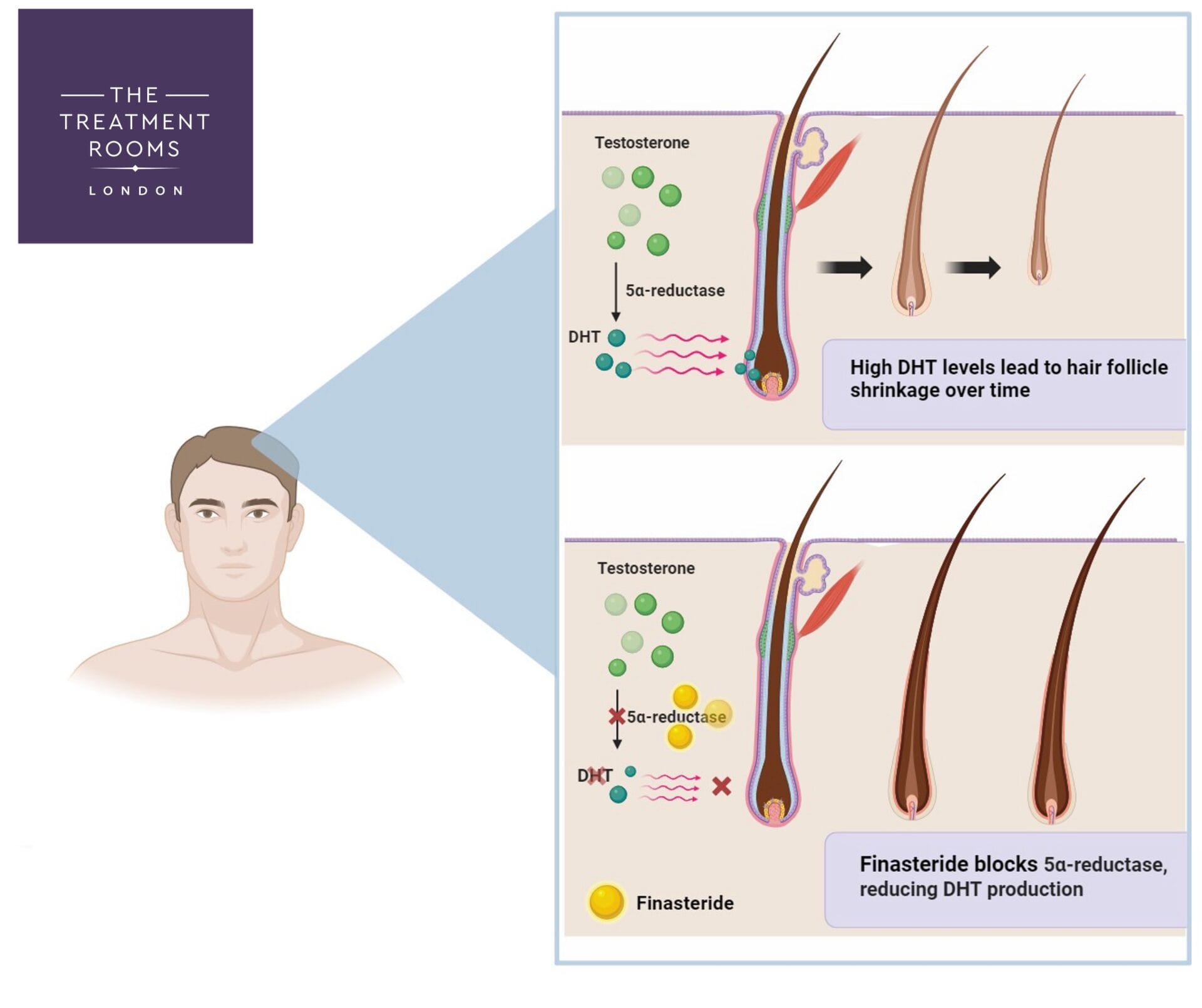Quick Summary: Why do men go bald?
Men go bald often due to male pattern baldness: Also named androgenetic alopecia, it is a condition characterised by progressive hair loss, primarily at the temples and crown of the head.
Causes of male pattern baldness: Genetic predisposition, hormonal factors like DHT (dihydrotestosterone, a sex hormone and subtype of Testosterone), aging, lifestyle choices, and environmental influences.
Practical advice for managing hair loss: Maintaining a balanced diet, managing stress, avoiding harsh hair treatments, and seeking professional guidance when necessary can help keep hair healthy and on your head by using medications like Finasteride and Minoxidil.
Recovering hair when you are bald: This is best achieved by undergoing a hair transplant, a procedure which relocates hair from the back and sides of the scalp to an area of thinning or balding.
Androgenetic alopecia, commonly referred to as male pattern baldness, is a common condition that impacts millions of men globally. Despite its prevalence, the underlying causes remain a subject of interest and concern for many. What causes men to go bald?
In this comprehensive guide, we will delve into the science behind male pattern baldness, exploring its causes, risk factors, and potential solutions.
Why Do Men Go Bald?
Male pattern baldness is characterised by a progressive loss of hair in a well-defined pattern, typically starting at the temples and crown of the head. This is the most common cause of men going bald. Over time, the hairline moves back (recedes) to form a characteristic “M” shape. Hair also thins at the top of the head (vertex or crown), often progressing to partial or complete baldness1.
Why Do More Men Go Bald And Not Women?
While it primarily affects men, women can also experience a similar pattern of hair loss, though it is less common. This is because throughout a woman’s life, they have less activity of DHT, the main hormone that contributes to balding. In men, hormone levels of DHT are higher and more active, and they tend to lose hair earlier leading to the characteristic pattern of hair loss in the hairline and crown.
Genetics Related to Balding
Research indicates that androgenetic alopecia is associated with genes inherited from both parents. This is contrary to the common belief that it is passed down solely through the maternal line (for example, from your mother’s father).
Studies have shown that there are specific genes that increase the risk of developing male pattern baldness3, suggesting that individuals with a family history of baldness might need to consider intervention strategies earlier on.
Hormonal Factors
Dihydrotestosterone (DHT), a hormone derived from testosterone, is a critical component in the process of male pattern baldness. It is produced in the testes and adrenal glands, and is responsible for the development of male sexual characteristics, such as facial hair, deepening of the voice and muscle growth.
However, in people with androgenic alopecia, hair follicles are more sensitive and affected by DHT, causing them to shrink. This phenomenon results in the gradual thinning and falling out of hair follicles over time and eventually balding.
The Connection Between Aging and Hair Loss
Age is another significant factor in male pattern baldness. While hair loss can occur at any age, it is most commonly observed in older men. As men age, their hair follicles may become increasingly susceptible to the effects of DHT, leading to gradual thinning and eventual baldness.
The statistics are quite revealing when examining the prevalence of this condition among caucasian men. By the age of 30, up to 30% of white men will have androgenetic alopecia. This percentage increases with age, with up to 50% of white men experiencing this condition by the age of 50. By the time they reach 70 years of age, the prevalence of androgenetic alopecia among white men rises to as high as 80%5.
Lifestyle and Environmental Factors
While hormones play a predominant role in male pattern baldness, lifestyle and environmental factors can also influence the onset and progression of hair loss. Smoking, excessive alcohol consumption, poor nutrition, and high levels of stress have all been associated with an increased risk6.
Furthermore, environmental factors such as exposure to pollutants and UV radiation can damage hair follicles and accelerate loss. It is essential to adopt a healthy lifestyle and minimise exposure to harmful environmental toxins to maintain optimal hair health7.
Practical Tips for Managing Hair Loss
While male pattern baldness may be inevitable for some individuals, there are several strategies that can help manage hair loss and promote healthy hair growth:
- Maintain a Balanced Diet: Ensure your diet is well-balanced by including nutrient-dense foods like fruits, vegetables, lean proteins, and healthy fats, which contribute to the health of your hair. For tips on nutrition and hair health, check out our blog post “Diet for Healthy Hair: The Ultimate Nutrition Guide”.
- Manage Stress: Practice stress-reducing techniques such as meditation, yoga, or deep breathing exercises to mitigate the effects of stress on the body and on hair.
- Avoid Harsh Hair Treatments: Reduce the usage of styling products, heat styling tools, and harsh chemicals, as they have the potential to harm hair follicles and worsen hair loss.
- Consult a Specialist: If you are experiencing significant hair loss, consider seeking advice from a hair care professional who can provide treatment options tailored to your needs. Treatments may include topical treatments such as Minoxidil and oral medications such as Finasteride. Finasteride works by blocking the conversion of testosterone to DHT. By reducing the DHT levels, Finasteride can help to reverse the process of hair loss and promote hair regrowth in men. In certain circumstances, more permanent solutions, such as hair transplants can be explored. For more in-depth advice into what works best for you and your hair, please do not hesitate to get in touch with our clinic. At The Treatment Rooms, we provide tailored care and treatment options.

Conclusion
Male pattern baldness is a complex condition influenced by a combination of hormonal and environmental factors. While it may not be entirely preventable, understanding the underlying causes of hair loss can empower individuals to take proactive steps to manage their condition effectively. By adopting a healthy lifestyle, seeking professional guidance, and exploring available treatment options, men and women can regain confidence and maintain optimal hair health for years to come.
References
- Androgenetic alopecia: MedlinePlus Genetics (2023) [Internet]. Available at: https://medlineplus.gov/genetics/condition/androgenetic-alopecia/
- Hagenaars, S. P., Hill, W. D., Harris, S. E., Ritchie, S. J., Davies, G., Liewald, D.C., Gale, C. R., Porteous, D. J., Deary, I. J. and Marioni, R. E. (2017) ‘Genetic prediction of male pattern baldness’, PLoS Genet, 13 (2): e10065941. Available at: https://www.ncbi.nlm.nih.gov/pmc/articles/PMC5308812/
- Hillmer, A. M., Hanneken, S., Ritzmann, S., Becker, T., Freudenberg, J., Brockschmidt, F. F., and Nothen, M. M. (2005) ‘Genetic variation in the human androgen receptor gene is the major determinant of common early-onset androgenetic alopecia’, American Journal of Human Genetics, 77(1), 140-148. Available at: https://doi.org/10.1086/431425
- Trueb, R. M. (2002) ‘Molecular mechanisms of androgenetic alopecia’, Experimental Gerontology, 37(8-9), pp. 981-990. Available at: https://pubmed.ncbi.nlm.nih.gov/12213548/#:
- Choi, E., Song, J., Lee, Y., Jeong, Y. and Jang, W. (2024) ‘Prioritizing susceptibility genes for the prognosis of male-pattern baldness with transcriptome-wide association study’, Human Genomics, 18(34). Available at: https://www.ncbi.nlm.nih.gov/pmc/articles/PMC10985920/
- Trüeb, R. M. (2003) ‘Association between smoking and hair loss: another opportunity for health education against smoking?’, Dermatology, 206(3), pp. 189-191. Available at: https://pubmed.ncbi.nlm.nih.gov/12673073/#
- Trüeb, R. M. (2003) ‘Effect of ultraviolet radiation, smoking and nutrition on hair’, Current Problems in Dermatology, 31, pp. 154-165. Available at: https://pubmed.ncbi.nlm.nih.gov/26370649/
Share:
Authored by
Reviewed by
Book a Consultation
Related Blogs
Castor Oil (Ricino Oil) for Hair Growth: Benefits, Uses & How to Apply for Maximum Results
June 26, 2025
Castor oil, also known as Ricino oil, is extracted from the Castor bean plant (Ricinus communis). During…
What is a Hair Transplant? How it Works, Success Rate & What to Expect
June 23, 2025
Hair transplantation is a cosmetic surgical procedure that restores hair by moving healthy follicles from one part…
John Cena Hair Transplant
May 14, 2025
John Cena, a common household name, is a figure who has effortlessly straddled the worlds of professional…
Kyle Walker Hair Transplant: Before, After, and His New Hairline
May 12, 2025
Kyle Walker is known for his defensive skills at Tottenham Hotspur, Manchester City, and in the England…
Celebrity Hair Transplants: Full Before and After Analysis
May 8, 2025
Elon Musk Hair Transplant Elon Musk, the billionaire behind Tesla and SpaceX, is well-known for his innovations…
Lewis Hamilton Hair Transplant: Before, After, and His New Hairline
May 7, 2025
As a top-class racing driver, Hamilton is used to wearing a race helmet. While this does protect…
James Nesbitt Hair Transplant: Before, After, and His New Hairline
May 6, 2025
James Nesbitt, the Northern Irish actor famed for his role as Adam Williams in the British comedy-drama…
How Many Hair Grafts Do You Need For A FUE Hair Transplant?
May 3, 2025
An Follicular Unit Excision (FUE) or FUT hair transplant are 2 main procedures available to address hair…
Cristiano Ronaldo’s Hair and Hairline
May 2, 2025
Cristiano Ronaldo, the football icon, is celebrated as much for his on-field brilliance as his impeccably groomed…











